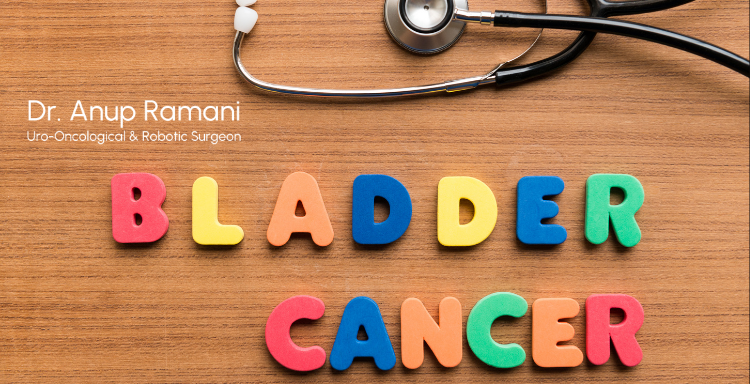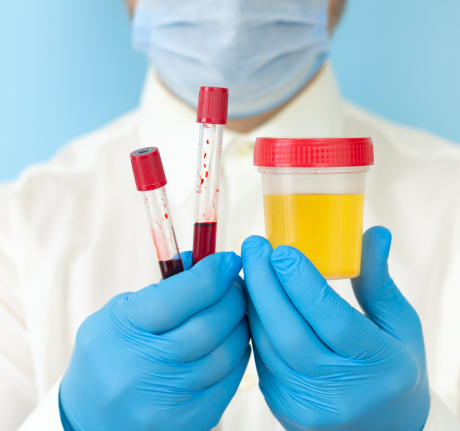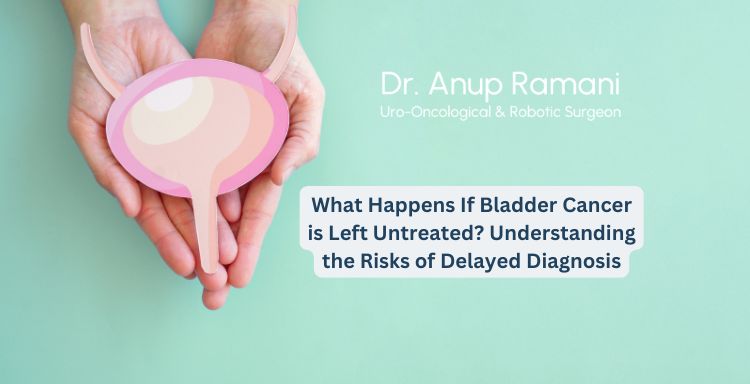Dr Anup Ramani @ Copyright 2024
By Dr. Anup Ramani
Bladder cancer, a type of cancer that begins in the cells of the urinary bladder, is among the most common cancers affecting the urinary system. It often starts in the lining of the bladder, where abnormal cells grow uncontrollably. Early detection and treatment of urinary bladder cancer can dramatically improve the prognosis and quality of life for patients. However, when left untreated, bladder cancer can lead to severe complications, including metastasis (spread to other organs) organ failure and even death.
In this article, we explore what happens when bladder cancer is left untreated, the risks involved and the importance of timely bladder cancer treatment. We will also examine the options available for bladder cancer surgery, particularly in regions like India, where advanced treatment options are widely accessible.
The Risks of Untreated Bladder Cancer
Bladder cancer, if left untreated, may evolve from localized tumors to more aggressive forms that invade other organs. The progression of this disease can result in life-threatening complications. Below are the significant risks associated with untreated bladder cancer:

Increased Tumor Size and Spread
As bladder cancer grows, the tumor may infiltrate deeper layers of the bladder wall and potentially spread to surrounding tissues. The primary concern is the possibility of metastasis, where cancer cells move through the bloodstream or lymphatic system to distant organs, most commonly the lungs, liver and bones. This makes treatment more complicated and less effective.
Organ Dysfunction and Loss of Bladder Function
A growing bladder tumor can obstruct the normal functioning of the bladder, causing difficulty in urination, retention of urine and infections. In advanced stages, the tumor can spread to nearby organs like the kidneys, leading to renal failure. If the bladder is severely affected, its ability to hold and release urine may be impaired, leading to incontinence or the need for a urinary diversion procedure.
Pain and Discomfort
Untreated bladder cancer may cause persistent pain, especially as the tumor grows and presses against surrounding organs or nerves. Patients may experience painful urination, pelvic pain and discomfort in the lower abdomen. Additionally, as the cancer spreads, pain may intensify and become chronic, requiring more intensive pain management strategies.

Hematuria (Blood in Urine)
One of the most common symptoms of bladder cancer is hematuria or blood in the urine. As the cancer progresses, bleeding may increase, leading to visible blood in the urine or microscopic blood, which can be detected through a urine test. This bleeding can lead to anemia, a condition characterized by a shortage of red blood cells, causing fatigue and weakness.
Risk of Death
If bladder cancer is left untreated, the risk of death increases significantly. The cancer can spread to vital organs, such as the lungs, liver and bones, where it may be difficult to treat or manage effectively. Without proper medical intervention, the disease can become fatal.
Why Early Diagnosis and Treatment are Critical?
The primary goal of bladder cancer treatment is to remove or destroy the cancerous cells while preserving as much of the bladder’s function as possible. Early diagnosis plays a key role in preventing the progression of the disease and reducing the risk of metastasis. In many cases, early-stage bladder cancer is highly treatable with bladder cancer surgery or other medical therapies.
Bladder Cancer Treatment Options
Bladder Cancer Surgery is one of the most effective treatments for patients with invasive bladder cancer. Depending on the stage and spread of the cancer, various surgical options are available:
- Transurethral Resection of Bladder Tumor (TURBT): For early-stage, superficial bladder cancers, TURBT is a minimal invasive surgery used to remove tumors from the bladder. This procedure is typically followed by intravesical therapy to prevent recurrence.
- Radical Cystectomy: In cases where the cancer is invasive and has spread beyond the inner lining, radical cystectomy may be recommended. This involves the removal of the entire bladder and nearby lymph nodes. For some patients, a neobladder or urinary diversion may be constructed to allow continued urination.
- Robotic Surgery: Advanced robotic techniques have made bladder cancer surgery less invasive, offering smaller incisions, less pain and quicker recovery times.
Bladder Cancer Treatment in India: Advanced Options for Patients
India has become a global destination for bladder cancer treatment due to its advanced medical facilities and highly skilled surgeons. Many hospitals in India, particularly in major cities like Mumbai, offer state-of-the-art treatment for urinary bladder cancer, a technique that minimizes trauma to the body and speeds up recovery.
India’s healthcare system offers several advantages:
- Cost-Effective Treatment: Bladder cancer treatments in India are significantly more affordable than in many Western countries without compromising on quality.
- Advanced Medical Infrastructure: Many hospitals in India are equipped with the latest technologies and provide comprehensive care, from diagnosis to post-surgery rehabilitation.
What Our Patients Are Saying
The Importance of Timely Intervention
The risks of leaving bladder cancer untreated are severe and can significantly compromise the patient’s health and quality of life. Early intervention is key to preventing further complications and improving the chances of successful treatment. If you or someone you know is experiencing symptoms such as blood in the urine, frequent urination, and pain during urination or pelvic discomfort, it is crucial to seek medical attention as soon as possible.
Bladder cancer surgery offers a high success rate, especially when the cancer is detected early. Consulting with Dr. Anup Ramani, is essential for understanding the best course of action and ensuring the most effective treatment.
Conclusion
Bladder cancer, if left untreated, can lead to severe health complications, including the spread of cancer to other organs, loss of bladder function and even death. Timely diagnosis and treatment, including urinary bladder cancer surgery, play a critical role in improving outcomes and survival rates. With advancements in treatment, particularly in countries like India, patients have access to highly effective and affordable care options. Patients are strongly advised to seek immediate medical attention if they experience symptoms related to bladder cancer, as early intervention is key to preventing the disease from advancing and improving overall prognosis.
FAQs
What are the early symptoms of bladder cancer?
Early symptoms of bladder cancer include blood in the urine (hematuria), frequent urination, and pain during urination and pelvic discomfort.
How is bladder cancer diagnosed?
Diagnosis typically involves a combination of urine tests, cystoscopy, biopsy and imaging studies such as CT or MRI scans.
Can bladder cancer be cured if detected early?
Yes, if bladder cancer is detected early and treated promptly, the chances of successful treatment are high, with many patients achieving complete remission.
What is robotic bladder cancer surgery
Robotic bladder cancer surgery is a minimal invasive procedure that uses robotic systems to remove bladder tumors with greater precision, resulting in less pain and faster recovery.
Why is bladder cancer treatment in India popular?
India offers advanced bladder cancer treatments at a fraction of the cost compared to Western countries, with skilled surgeons and modern medical infrastructure.
About Author

Uro-Oncological & Robotic Surgeon
Dr. Anup Ramani is a robotic uro-oncological surgeon and an internationally recognized expert in robotic surgery for prostate, kidney and urinary bladder cancers. With more than two decades of robotic experience and 2,000+ robotic procedures, he brings unmatched precision and outcomes to complex uro-oncology cases. He is widely published in his field and is known for a personal, transparent approach-often spending over an hour in initial consultations to educate patients on its disease, surgery and recovery. His expertise spans prostate cancer treatment, kidney and bladder cancer surgery, adrenal gland surgery, kidney stone treatment, penile cancer surgery and enlarged prostate management. Dr. Ramani advocates the advantages of robotic surgery-magnified 3D vision, tremor-filtered precision, minimal scarring, lower blood loss and faster recovery-helping patients return to life sooner.
Best Uro-Oncological surgeon
Specialist in India for Robotic Surgery
MCh, DNB, MS, DNB
Dr. Anup Ramani
CONTACT
Uro-Oncologist in India,
Best Robotic Surgeon for Uro Oncology Surgery
1407, One Lodha Place Next to World Towers Senapati Bapat Marg, Worli, Mumbai. 400013.
Dr Anup Ramani @ Copyright 2024 – Website Maintenance, SEO & GEO by Opal Infotech
- Partial penectomy is done in cases where glans and distal penis is involved with carcinoma.
- Partial penectomy is a type of organ-preserving surgery. Preservation of sexual and micturational function depends on the surgical dissection and reconstruction of residual urethra.
- Patients who develop stones in the kidney or ureter, often experience severe pain.
- This condition usually needs a procedure to remove the kidney stones.
- This procedure is called ureteroscopy and is performed very commonly.
- It does not require any cuts and hence it is painless.
- The procedure is performed with an endoscope inserted through the penis under spinal anesthesia.
- The scope is inserted through the penis into the kidney and stones are dissolved with a laser.
- The procedure takes about 40-50 minutes.
- A catheter (urine pipe) is kept after the procedure to drain the bladder. A stent is kept in the kidney at the same time.
- Patient is mobile and walking in the room the same evening.
- Hospital stay is one night and patient is discharged the next day after removal of the catheter.
- Patient has to come back after six weeks to remove the stent in the kidney.
- Patients can resume office a week after surgery and heavy activities like running, weight lifting, a month after the procedure.
- We offer fixed packages for this procedure which can be obtained by calling our helpline +91 9967666060.
- Men with an enlarged prostate, which is a normal ageing changes, often experiencing difficulty passing urine. This condition usually needs a procedure to trim the prostate and relieve the blockage.
- This procedure is called TURP and is performed very commonly.
- It does not require any cuts and hence it is painless.
- The procedure is performed with an endoscope inserted through the penis under spinal anaesthesia.
- The overgrown prostate is dissolved with a laser bloodlessly.
- The procedure takes about 40 minutes.
- A catheter (urine pipe) is kept after the procedure to drain the bladder.
- Patient is mobile and walking in the room the same evening.
- Hospital stay is two nights and patient is discharged with the catheter, which is removed after 4 days.
- Patients can resume office a week after surgery and heavy activities like running, weight lifting, a month after the procedure.
- We offer fixed packages for this procedure which can be obtained by calling our helpline +91 9967666060.
-
Robotic adrenalectomy is a sophisticated, complex surgery and it is very important that an experienced surgeon performs this surgery to avoid major complications.
-
Once the anesthesia is done, and patient positioned, three micro cuts (3mm each) are made in the patient’s abdomen.
-
The arms of the Da Vinci robot are connected to the cuts via ports (tubes).
-
Dr. Ramani then sits in the controlling console to perform the surgery.
-
On an average, a robotic adrenalectomy takes one hour.
-
The surgery is almost completely bloodless and there has never been any need to transfuse blood after surgery.
-
A urine catheter and bag to drain the bladder is inserted during surgery.
-
A tiny drain pipe may be inserted in the surgical side of the abdomen, connected to a bag.
-
Patient is kept nil-by-mouth the day of the surgery, with IV fluids. Sips of water are started the next day and solid food by day three.
-
The drain pipe, if kept, is removed in the room on day 2 after surgery.
-
The catheter is removed on day two after surgery.
-
Total hospital stay for robotic adrenalectomy is 4 nights (including night before surgery).
-
Post discharge, a doctor from the surgical team visits the patient at home/ hotel room once every day.
On the day of discharge, patient is totally self-sufficient. They are able to walk freely without any pain, dress themselves, shower, toilet and they do not need to hire any nurse or help at home. Almost all patients are back to work within 2 weeks of surgery.
Heavy activities like running, weight lifting can be resumed after a month
Follow up after an adrenalectomy is in the form of CT scans, once a year for 5 years.
Local patients usually meet Dr. Ramani after two weeks to discuss report.Outstation patients are counselled on a phone consultation.
- Dr. Ramani is one of the very few surgeons in India who has the expertise to perform a robotic surgery for bladder cancer, which includes removing the urinary bladder and reconstructing a new bladder robotically.
- Robotic radical cystectomy is an extremely sophisticated, complex surgery and it is very important that an experienced surgeon performs this surgery to avoid major complications.
- Once the anaesthesia is done, and patient positioned, six micro cuts (3mm each) are made in the patient’s abdomen.
- The arms of the Da Vinci robot are connected to the cuts via ports (tubes).
- Dr. Ramani then sits in the controlling console to perform the surgery.
- On an average, a robotic radical cystectomy with an ileal conduit takes 3-4 hours.
- The surgery is almost completely bloodless and there has never been any need to transfuse blood after surgery.
- A urine catheter and bag to drain the new bladder is inserted during surgery.
- Two tiny drain pipe in inserted in the surgical side of the abdomen, connected to a bag.
- Patient is kept nil-by-mouth for 4 days after surgery with IV supplementation of patient’s daily requirements of calories, fats, carbohydrates, proteins and electrolytes.
- The drain pipes are removed in the room on day 3-5 after surgery.
- Total hospital stay for radical cystectomy is 8 nights (including night before surgery).
- Post discharge, a doctor from the surgical team visits the patient at home/ hotel room once every day.
- On the day of discharge, patient is totally self-sufficient. They are able to walk freely without any pain, dress themselves, shower, toilet and they do not need to hire any nurse or help at home.
- Almost all patients are back to work within 6 weeks of surgery. Heavy activities like running, weight lifting can be resumed after two months.
Follow up after a radical a cystectomy is in the form of CT scans, once a year for 5 years.
Histopathology report: Local patients usually meet Dr. Ramani after two weeks to discuss report.
Outstation patients are counselled on a phone consult. Depending on the report, patient may or may not need chemotherapy after surgery.
If chemo is needed, patients may choose to get it done with a medical oncologist of their choice or avail the services of one of the four medical oncologists on our team.
- Robotic partial nephrectomy is a sophisticated, complex surgery and it is very important that an experienced surgeon performs this surgery to avoid major complications. Robotic radical (total) nephrectomy is
- relatively easier but still requires significant experience to consistently deliver results.
- Once the anaesthesia is done, and patient positioned, five micro cuts (3mm each) are made in the patient’s abdomen.
- The arms of the Da Vinci robot are connected to the cuts via ports (tubes).
- Dr. Ramani then sits in the controlling console to perform the surgery.
- On an average, a robotic radical nephrectomy takes one hour and a robotic partial nephrectomy takes about an hour and half.
- The surgery is almost completely bloodless and there has never been any need to transfuse blood after surgery.
- A urine catheter and bag to drain the bladder is inserted during surgery.
- A tiny drain pipe in inserted in the surgical side of the abdomen, connected to a bag.
- Patient is kept nil-by-mouth the day of the surgery, with IV fluids. Sips of water are started the next day and solid food by day three.
- The drain pipe is removed in the room on day 3 after surgery. The catheter is removed on day two after surgery.
- Total hospital stay for radical/partial nephrectomy is 4 nights (including night before surgery).
- Post discharge, a doctor from the surgical team visits the patient at home/ hotel room once every day.
- On the day of discharge, patient is totally self- sufficient.
- They are able to walk freely without any pain, dress themselves, shower, toilet and they do not need to hire any nurse or help at home.
- Almost all patients are back to work within 2-3 weeks of surgery.
- Heavy activities like running, weight lifting can be resumed after a month.
- Follow up after a radical/partial Nephrectomy is in the form of CT scans, once a year for 5 years.
- Local patients usually meet Dr. Ramani after two weeks to discuss report.
- Outstation patients are counselled on a phone consultation.





